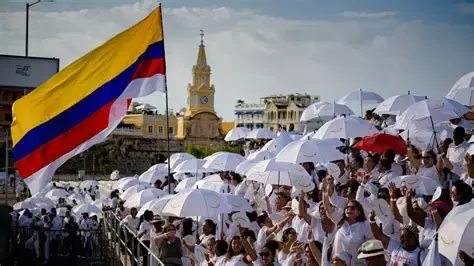Russia and Iran: Parallel Strategies in Latin America
- Cristina Saddi

- Nov 5, 2024
- 6 min read
Written by Cristina Saddi (BSc Politics and Economics)
Russia’s involvement in Latin America can be traced back to the 19th century, with the establishment of embassies in Brazil in 1828 and Mexico in 1890 under the Russian Empire. This engagement intensified during the Soviet era, particularly throughout the Cold War, as Moscow sought strategic footholds in countries marked by anti-U.S. sentiments, and interstate/intrastate rivalries. The Soviet leadership channelled military and economic support across Argentina, Cuba, Peru, and Nicaragua - notably backing the Sandinista revolutionaries to counter U.S. hegemony and solidify its presence in the hemisphere. Following the collapse of the Soviet Union, the Russian federation, under Boris Yeltsin, reduced its presence in the hemisphere due to economic difficulties and a new foreign policy direction that favoured rapprochement with Washington. However, the resurgence of tensions with the U.S. in the mid-2000s led Moscow to renew and strengthen ties with its old Cold War allies such as Cuba and Nicaragua, while also forming new alliances with countries like Venezuela that opposed U.S. hegemony.
Similarly, following the 1979 Iranian Revolution which broke ties with the U.S., Tehran capitalised on the anti-American sentiment stemming from U.S. backing of overthrown regimes in Central America. The shared disdain for U.S. hegemony allowed Iran to expand its relationships in the hemisphere, notably with Ortega in Nicaragua. The Cold War’s conclusion initiated peace negotiations with militant leftist groups in Latin America, leading to a decline in anti-U.S. sentiment throughout the region. Concurrently, Iranian proxy Hezbollah and its affiliate, Islamic Jihad, established a foothold in the hemisphere, claiming responsibility for operations against U.S. and Jewish interests in South America in the 1990s. The landscape shifted again with the height of the ‘Pink Tide’ which carried leftist and U.S.-sceptical governments into power across Latin America, renewing opportunities for Iran. Particularly, under Chávez, Venezuela and Iran, united in their mutual opposition to U.S. hegemony and driven by their ambition to propagate this stance among other governments, forged a strategic partnership. This alliance granted Iran a gateway into the hemisphere, through Venezuela’s considerable diplomatic influence. This was evident between 2005 and 2009, as Iran inaugurated six new embassies in Latin America - in Bolivia, Chile, Colombia, Ecuador, and Uruguay - adding to the five embassies in operations. The Venezuela-Iran alliance has not only persisted but also thrived over the years, especially as the Trump administration increased ‘maximum-pressure’ sanctions on both countries.

Qasem Soleimani alongside former President Hugo Chávez
Today, amid increasing pressure from the U.S. and Western allies, Russia and Iran have strengthened their ties not only with anti-U.S. regimes in Cuba, Nicaragua, and Venezuela but also with countries like Mexico or Brazil that maintain a more neutral stance. Latin America has become a strategic platform for both countries to build support against what they perceive as ‘Collective West’ dominance, advocating for a multipolar world order. This diplomatic manoeuvring could also mitigate their economic isolation, potentially offsetting the impact of Western sanctions. Finally, in light of their involvement in ongoing conflicts, Russia and Iran could leverage these partnerships to boost their military capabilities and provide havens for militias and mercenaries, benefiting from the reduced scrutiny in the region.
Unified Anti-Western Narrative: Diplomatic Engagement and Influence Operations
The primary alignment in Russia and Iran’s diplomatic strategies in Latin America emerges from their portrayal as ‘nations unjustly harassed by the West’. Both countries advocate for the establishment of a new, multipolar world order, seeking alliances with Marxist and leftist regimes to challenge imperialist powers. This strategy became particularly pronounced in the wake of Russia’s full-scale invasion of Ukraine. By presenting the West as the oppressor, Russia managed to secure sympathy and tacit support from regional powers like Brazil and Mexico - both of which notably abstained from signing the final communiqué at the June 2024 Ukraine peace summit. Similarly, Iran has positioned itself as a testament of successful resistance against foreign interference, despite its blend of religion and politics contradicting the essence of a secular and democratic left. This narrative has resonated with several political parties and leaders across the hemisphere, who have aligned with Tehran’s rhetoric and stances on various issues. Notably, in light of the ongoing war in Gaza, Iran has positioned itself as the self-proclaimed leader of the axis of resistance, capitalising on widespread support among Latin American governments for the Palestinian cause - with the notable exception of Milei’s Argentina.
Beyond their diplomatic rhetoric, both countries strategically use information manipulation and propaganda to shape public attitudes towards foreign policy, with a high degree of overlap. Capitalising on widespread distrust in political leaders and democratic institutions - fuelled by corruption and the failure to deliver public services - both nations have found fertile ground for their propaganda to spread swiftly across the region. For instance, Moscow has secured media contracts across the continent, leveraging platforms like RT news and Sputnik, along with regional affiliates, to amplify anti-West rhetoric and disseminate conspiracy theories about ‘denazifying Ukraine’ or falsely alleging Ukraine’s involvement in weapon sales to Hamas. Iran’s state-funded news outlet, HispanTV, oriented specifically to the Latin American audience, has ramped up similar propaganda efforts in the hemisphere. Through narratives that criticise U.S. policy as imperialistic, it positions Iran, Russia, and China as challengers to U.S. dominance and advocates for economic growth in Latin America. This coordinated effort between Russia and Iran extends beyond traditional media, evident in groups like Nova Resistência - a Brazilian quasi-paramilitary neo-fascist organisation inspired by Dugin’s Fourth Political Theory - which actively promotes pro-Russian narratives and voice support for Iran and Hezbollah.
Shared Energy Diplomacy: Leveraging Partnerships to Mitigate Economic Isolation
Despite their relatively small economic footprint in Latin America compared to the U.S. and Europe, Russia and Iran are seemingly expanding their influence in the region’s energy sector. This strategic, and occasionally coordinated, effort seeks to mitigate the effects of their global economic insolation brought on by international sanctions. Recent data reveal a striking spike in Russian diesel exports to Brazil, which soared to 6.1mn tonnes of diesel in 2023 - a 6,000 per cent increase from the 101,000 tonnes of the previous year. This positions Brazil, a country heavily reliant on affordable diesel for its transportation and agribusiness sectors, as Russia’s largest buyer of diesel. This highlights Russia’s strategy to establish itself as an indispensable energy supplier in a sensitive market. Similarly, Iran has leveraged its experience in navigating global sanctions to establish itself as an essential player in Venezuela’s oil sector. Under the Maduro regime, Iran has invested billions in Venezuelan refineries, pipelines and drills, while also playing a crucial role in facilitating oil exports. Meanwhile, Russian companies such as Rosneft, which withdrew from Venezuela due to U.S. sanctions, are subtly suggesting a possible re-engagement, highlighted by CEO Igor Sechin’s visit to Caracas in March 2023.

Venezuelan Oil Minister Tareck El Aissami and Rosneft CEO Igor Sechin in March 2023
Common Military Approach: Leveraging Military Cooperation and Proxy Alliances
Russia and Iran have both been involved in different activities of military and security cooperation. Involved in sales - Russia used to be the 3rd biggest supplier of weapons in the hemisphere between 2003 and 2023 - but also joint training, dual-use facilities and deployment of military assets with Latin America countries. For instance, in June 2022, the Sandinista-dominated Nicaraguan congress authorised the entry of Russian troops, military ships and aircrafts into the country, citing the purpose as an ‘exchange of experiences and training’. Iran has also expanded its military presence in Venezuela and Bolivia, notably supplying Peykaap-III fast attack boats equipped with 25 anti-ship missiles to Maduro’s Venezuela - raising concerns amid the ongoing territorial disputes with Guyana.
However, Iran’s security cooperation in the hemisphere is far less developed compared to Russia's and remains limited. Its military strategy in Latin America primarily relies on its non-state proxies, notably Hezbollah, whose regional presence dates back to the 1980s. Initially focused on the tri-border region between Argentina, Paraguay, and Brazi, Hezbollah’s operations have recently shifted towards Venezuela, where it has allegedly embedded itself in criminal networks to facilitate money laundering and illicit financial activity. In addition, the Lebanese shiite military group benefits from a well-established network of social infrastructure, enabling it to operate with relative impunity in the region, while also receiving support from global diaspora communities that bolster its resources and influence. Recently, Russia has also extended its strategy of using non-state proxies to the Western Hemisphere, adding to its global activities. Notably, amid widespread unrest and coup fears in Venezuela in 2019, Russia sent 400 mercenaries - allegedly from Wagner Group - to protect Maduro’s regime. The group is said to remain active in supporting the Venezuelan military’s training efforts and protecting mining operations in the Orinoco Mining Arc.
Conclusion
The parallel strategies of Russia and Iran in Latin America reveal a concerning alignment between the two countries, driven by their respective quests for global influence. It remains to be seen whether Russia and Iran will move towards a more coordinated approach, as many observers start to question the extent to which their interests will continue to converge.



Very insightful! Impressive Cristina!
Well done Cristina!! 👏👏